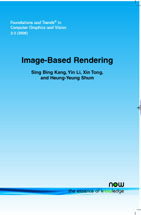Image-Based Rendering
By Sing Bing Kang, Microsoft Research, USA, sbkang@microsoft.com | Yin Li, Microsoft Corporation, USA, yl@microsoft.com | Xin Tong, Microsoft Research Asia, China, xtong@microsoft.com | Heung-Yeung Shum, Microsoft Research Asia, China, hshum@microsoft.com
Abstract
Image-based rendering (IBR) is unique in that it requires computer graphics, computer vision, and image processing to join forces to solve a common goal, namely photorealistic rendering through the use of images. IBR as an area of research has been around for about ten years, and substantial progress has been achieved in effectively capturing, representing, and rendering scenes. In this article, we survey the techniques used in IBR. Our survey shows that representations and rendering techniques can differ radically, depending on design decisions related to ease of capture, use of geometry, accuracy of geometry (if used), number and distribution of source images, degrees of freedom for virtual navigation, and expected scene complexity.
Image-Based Rendering
Image-based rendering (IBR) is unique in that it requires computer graphics, computer vision, and image processing to join forces to solve a common goal, namely photorealistic rendering through the use of images. IBR as an area of research has been around for about ten years, and substantial progress has been achieved in effectively capturing, representing, and rendering scenes.
Image-Based Rendering surveys the various techniques used in the area. It shows that representations and rendering techniques can differ radically, depending on design decisions related to ease of capture, use of geometry, accuracy of geometry (if used), number and distribution of source images, degrees of freedom for virtual navigation, and expected scene complexity.
Image-Based Rendering is an invaluable resource for anyone planning or conducting research in this particular area, or computer graphics or vision generally. The essentials of the topic are presented in an accessible manner and an extensive bibliography guides towards further reading.

6 Point-Based Rendering
Commentary Submitted By: Sing Bing Kang, Microsoft Research, SingBing.Kang@microsoft.com. Date Accepted: 4/25/2007
- Levoy and Whitted [80] introduced points as a display primitive in 1985; interestingly, no papers on point-based graphics were published until 1998 [GROSSMAN98].
- [GROSSMAN98] J. P. Grossman and W. Dally, “Point sample rendering”, in Rendering Techniques, 1998, pp. 181-192.
6.1 Forward Mapping
Commentary Submitted By: Sing Bing Kang, Microsoft Research, SingBing.Kang@microsoft.com. Date Accepted: 4/25/2007
- Meanwhile, Qsplat [RUSINKIEWICZ00] is a point-based system that converts large meshes into hierarchies of bounding spheres for efficient rendering.
- [RUSINKIEWICZ00] S. Rusinkiewicz and M. Levoy, “QSplat: A multiresolution point rendering”, in Proceedings of ACM SIGGRAPH, 2000, pp. 343-352.